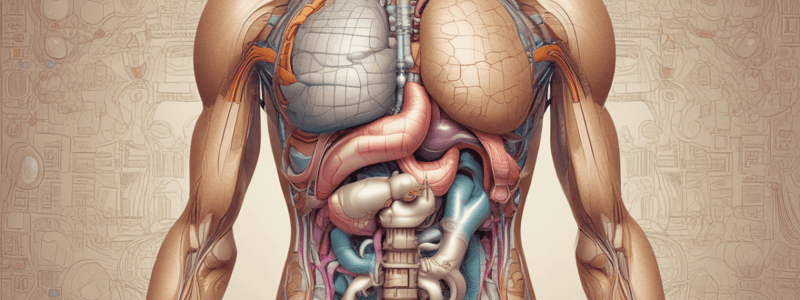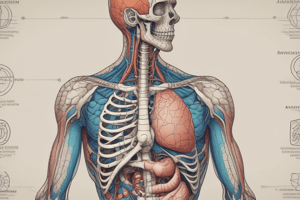Podcast
Questions and Answers
What is the name of the duct that branches from the common hepatic duct?
What is the name of the duct that branches from the common hepatic duct?
- Cystic duct (correct)
- Hepatic duct
- Common bile duct
- Portal vein
What is the main function of salivary amylase in the digestion process?
What is the main function of salivary amylase in the digestion process?
- To break down carbohydrates into simple sugars
- To break down proteins into peptides
- To break down starch into maltose (correct)
- To break down fats into fatty acids
At what pH range does protein digestion occur?
At what pH range does protein digestion occur?
- pH 1.5-2 (correct)
- pH 7-8
- pH 11-12
- pH 9-10
What is the role of pepsin in protein digestion?
What is the role of pepsin in protein digestion?
What is the name of the vein that receives blood from the liver?
What is the name of the vein that receives blood from the liver?
What is the function of iodine solution in the experiment?
What is the function of iodine solution in the experiment?
What is the result of chemically digesting starch in the mouth?
What is the result of chemically digesting starch in the mouth?
What is the role of hydrochloric acid in digestion?
What is the role of hydrochloric acid in digestion?
At what age during childhood should toilet training be started?
At what age during childhood should toilet training be started?
Which of the following is a factor affecting bowel elimination?
Which of the following is a factor affecting bowel elimination?
What is bowel incontinence?
What is bowel incontinence?
What is a cause of bowel incontinence?
What is a cause of bowel incontinence?
What is choletheliasis?
What is choletheliasis?
What is a factor that can affect bowel elimination?
What is a factor that can affect bowel elimination?
What is a condition associated with the digestive system?
What is a condition associated with the digestive system?
At what age should parents start introducing toilet training?
At what age should parents start introducing toilet training?
What is a common consequence of bowel incontinence?
What is a common consequence of bowel incontinence?
What is the function of the salivary glands?
What is the function of the salivary glands?
What is the pH range at which protein digestion occurs?
What is the pH range at which protein digestion occurs?
What is the main function of the stomach?
What is the main function of the stomach?
What is the role of bile in lipid digestion?
What is the role of bile in lipid digestion?
Where does lipid digestion occur in the human digestive tract?
Where does lipid digestion occur in the human digestive tract?
What is the function of the bile duct?
What is the function of the bile duct?
What is the purpose of the Valsalva maneuver during defecation?
What is the purpose of the Valsalva maneuver during defecation?
What is the function of the pancreas?
What is the function of the pancreas?
What is the function of the liver?
What is the function of the liver?
What type of muscle is the external anal sphincter?
What type of muscle is the external anal sphincter?
What is the function of the large intestine?
What is the function of the large intestine?
Which part of the GI tract is responsible for propelling feces towards the rectum?
Which part of the GI tract is responsible for propelling feces towards the rectum?
What is the function of the appendix?
What is the function of the appendix?
What are the sacral nerves that supply innervation to the muscles involved in defecation?
What are the sacral nerves that supply innervation to the muscles involved in defecation?
What is the function of the anus?
What is the function of the anus?
What is the effect of hydrochloric acid on proteins?
What is the effect of hydrochloric acid on proteins?
Flashcards are hidden until you start studying
Study Notes
Digestive System Anatomy
- The liver, common hepatic duct, cystic duct, common bile duct, gall bladder, hepatic veins, hepatic artery, and portal vein are all part of the digestive system anatomy.
Carbohydrate Digestion
- Iodine solution is an indicator of the presence of starch.
- During chewing, bread is mechanically and chemically digested by salivary amylase, breaking down starch into maltose.
- The color of bread changes from dark brown to brown or lighter brown as starch is broken down.
Protein Digestion
- Protein digestion occurs in the stomach and small intestine.
- Pepsin is the enzyme that digests protein, and hydrochloric acid helps to activate pepsin.
- Protein digestion occurs at a pH of 1.5-2.
Lipid Digestion
- Lipid digestion occurs in the mouth, stomach, and small intestine.
- Bile salts help to emulsify lipids, making them more accessible to lipase.
- Lipid digestion occurs at a pH of 3-6.3.
Defecation Physiology
- The sigmoid colon is responsible for propelling feces towards the rectum.
- The Valsalva maneuver and abdominal muscle contraction help to increase intra-abdominal pressure, aiding in bowel movements.
- The external anal sphincter is made up of striated muscle and is under voluntary control, while the internal anal sphincter is made up of smooth muscle and is under involuntary control.
Enrichment
- Five factors affecting bowel elimination include:
- Diet
- Fluid intake
- Exercise
- Stress
- Age
- Toilet training should start around 2-3 years of age.
- Bowel incontinence is the inability to control bowel movements, and can be caused by nerve damage or muscle weakness.
Studying That Suits You
Use AI to generate personalized quizzes and flashcards to suit your learning preferences.




